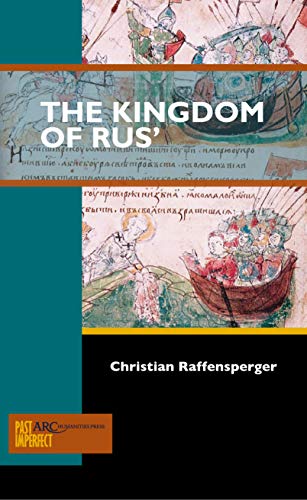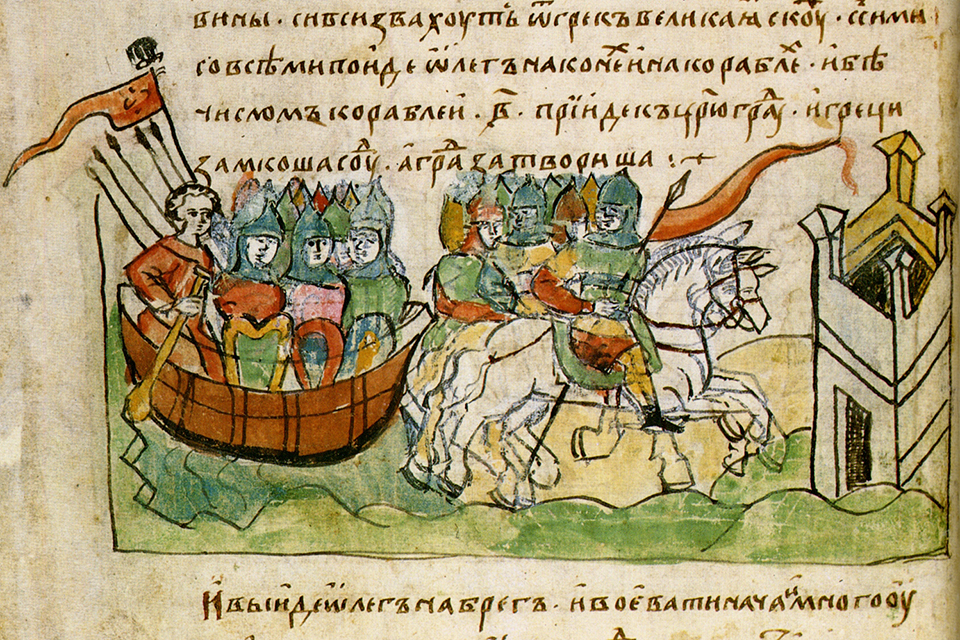This book explores how sloppy medieval history has downplayed the European significance of what has been considered a minor “barbaric” proto-state, the Kievan Rus’. On the way, the book mounts an impressive defence for reconsidering the centres and peripheries of Medieval Europe at the turn of the first Millenium
The Kingdom of Rus’
By Christian Raffensperger
Series Past Imperfect
Arc Humanities 2017
 “The Kingdom of Rus'” is an essential and thought-provoking book that every medieval historian should read. The book unravels how mistranslation of medieval sources and sloppy history-writing has served to downsize one of the most extensive European realms at the turn of the millennium, the Kievan Rus’. Thus, the book opens up for a better and more balanced view of the history of Europe in the aftermath of the Carolingian period. However, the book also underwrites the need for medievalists to possess vast linguistic capabilities in order for them to manoeuvre inside what has been called “the linguistic turn”.
“The Kingdom of Rus'” is an essential and thought-provoking book that every medieval historian should read. The book unravels how mistranslation of medieval sources and sloppy history-writing has served to downsize one of the most extensive European realms at the turn of the millennium, the Kievan Rus’. Thus, the book opens up for a better and more balanced view of the history of Europe in the aftermath of the Carolingian period. However, the book also underwrites the need for medievalists to possess vast linguistic capabilities in order for them to manoeuvre inside what has been called “the linguistic turn”.
The key element used to demonstrate these critical insights has been the medievalist’s invention of a curious translation of “Kniaz”, the East Slavonic word for “King”, into duke, grand prince or just plain prince. The book details the consequences for understanding the Kievan Rus’ world and their role in a European historiographical context.
The book opens with a succinct presentation of the history of the Kievan Rus’ from the first arrival of the Rus – a group of Scandinavian Vikings – in Eastern Europe in the mid 9th century to the events in the 1240s. By setting up trading posts at first Ladoga, later Novgorod and finally Kyiv, they ended up controlling the highly valuable international trade between the Islamic Bagdad and Byzantium with the north. One of the traditional ways of organizing rulership was for these Scandinavian tradesmen and war-leaders to establish “kingdoms” governed by male dynasties of fathers and sons. Traditionally, all were rewarded with the titles of King, Konungr, Konge, Knes, Kniaz, király or książę. Also, but not mentioned in Raffensperger’s book, the same men carried compounded names involving the suffix – rik (same proto-Indo-European root as rex, Proto-Indo-European *h₃rḗǵs.). Examples are Horik (Eric) or Knutr hin Rike; or Rurik, the founder of the Russian dynasty, in old Norse, Rørik; (also known from Beowulf as Hredric).
This practice – where both a father and his sons were termed “kings” – was coupled to an old clannish and kindred-based thinking prevalent in Northern Europe in the Middle Ages. This way of thinking led to a bewildering array of “kings” presented to Latin Chroniclers, steeped in the Biblical tradition of thinking about kings as rulers who superseded each other, one after the other.
In practice, this conundrum led to confusion among medieval chroniclers about how to “write” about such rulers. Were they indeed kings or just masquerading as such? For example, the German Chronicler, Thietmar of Merseburg, had no problem identifying Vladimir the Great as a king but encountered problems when writing about the Polish duke. Without proper reflection, historians up to the 21st century generously adopted this idea that one might turn “kings” into princes, grand princes or dukes, thereby diminishing their status. In an Anglophile or French historiographic tradition, kings had to be independent rulers. Arguably, such was not the case in a Scandinavian (Germanic and pagan) context, where kings were thought of as clan-leaders operating inside a kindred-based dynastic and hierarchic clannish model versus a biblically inspired idea of kings as sole rulers over their kingdoms and involving primogeniture. To translate the vernacular titles of such mighty rulers as “kings” apparently did not sit well with numerous Western European historians since the 18th century. Raffenspergers quotes numerous cases.
This leads us to the other question, Raffensperker raises, namely, how did the Kniaz rule over the Kievan Rus’? Was it a loose confederacy? Or truly a kingdom in a Western European sense? Raffensperker presents a remarkable set of arguments for the former, yet also notes that in terms of power wielded, the Kniaz ruling the Kievan Rus’ were even mightier than what most Western Europe nations could field in the 9th and 10th centuries.
He notes, that yes, the fact that at any time in the 10th and 11th-centuries the whole of Eastern Europe squirmed with “Kniaz’es” did not imply that one particular overlord – namely the Kniaz in Kyiv – could not operate as a kind of Pater Familias ruling over both a dynasty and a kingdom. Thus, we know of Vladimir the Great and his son and heir that they were able to marry into the ruling families in most of Western Europe; they were also able to marry off their daughters and granddaughters in the same way. Also, both were able to wage war on an international scale, functioned as lawgivers, were able to take tribute and even experimented with mints. The latter is not mentioned by Raffensperger.
So were they kings? Arguably, they ruled over the most extensive realm in Europe at the turn of the millennium, covering a landmass from the Gulf of Finland to the Black Sea. This realm was filled with fortified trading posts, vibrant towns and grand cities, hence the name Gardarike, literally the kingdom of the castles. Through the kingdom, an unimaginable amount of wealth circulated in furs, slaves, silver and luxuries. Governed by a dynasty of kings, it differed only in one parameter, namely the polygamous practices, which enabled these rulers to produce impressive numbers of sons and daughters, which could be turned into local rulers and matrimonial assets. Matrimonial rules and regulations set up by the Roman Catholic Church sought to prohibit this. However, as the cases of Cnut the Great and later his nephew the Danish king, Sven Estridssøn, witness to, it took generations to get the newly converted pagans to live up to these strange and complicated rules interfering with the dynastic set of rules.
Keeping this tradition was obviously crucial in the kingdom of the Kievan Rus’. At times, this caused a situation where the kingdom was flooded with lordlings aspiring to outmanoeuvre their brothers, leading to internecine strife and civil war. Nevertheless, not calling Kievan Rus’ a mighty European power in the high Middle Ages and hence sideline its history for the wrangling between France, England and Germany are somewhat skewing the perspective.
Karen Schousboe
FEATURED PHOTO
Radziwill Chronicon fol 14-2. Oleg attacks Constantinople in AD 907. Source: Wikipedia Open Domain
